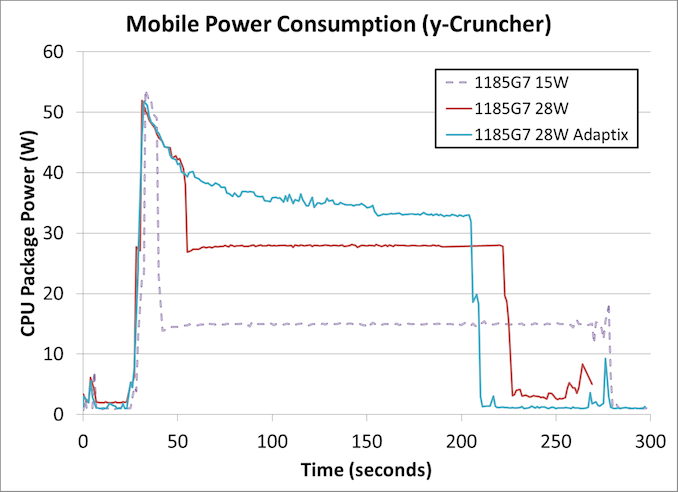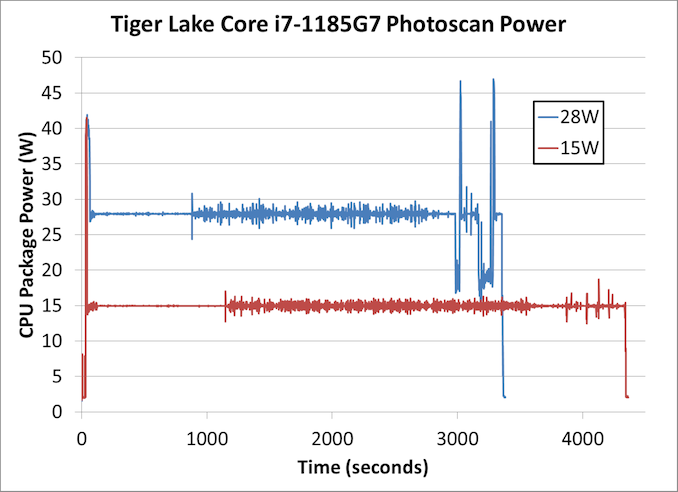Intel’s Tiger Lake 11th Gen Core i7-1185G7 Review and Deep Dive: Baskin’ for the Exotic
by Dr. Ian Cutress & Andrei Frumusanu on September 17, 2020 9:35 AM EST- Posted in
- CPUs
- Intel
- 10nm
- Tiger Lake
- Xe-LP
- Willow Cove
- SuperFin
- 11th Gen
- i7-1185G7
- Tiger King
Comparing Power Consumption: TGL to TGL
On the first page of this review, I covered that our Tiger Lake Reference Design offered three different power modes so that Intel’s customers could get an idea of performance they could expect to see if they built for the different sustained TDP options. The three modes offered to us were:
- 15 W TDP (Base 1.8 GHz), no Adaptix
- 28 W TDP (Base 3.0 GHz), no Adaptix
- 28 W TDP (Base 3.0 GHz), Adaptix Enabled
Intel’s Adaptix is a suite of technologies that includes Dynamic Tuning 2.0, which implements DVFS feedback loops on top of supposedly AI-trained algorithms to help the system deliver power to the parts of the processor that need it most, such as CPU, GPU, interconnect, or accelerators. In reality, what we mostly see is that it reduces frequency in line with memory access stalls, keeping utilization high but reducing power, prolonging turbo modes.
Compute Workload
When we put these three modes onto a workload with a mix of heavy AVX-512 compute and memory accesses, the following is observed.
Note that due to time constraints this is the only test we ran with Adaptix enabled.
This is a fixed workload to calculate 2.5 billion digits of Pi, which takes around 170-250 seconds, and uses both AVX-512 and 11.2 GB of DRAM to execute. We can already draw conclusions.
In all three power modes, the turbo mode power limit (PL2) is approximately the same at around 52 watts. As the system continues with turbo mode, the power consumed is decreased until the power budget is used up, and the 28 W mode has just over double the power budget of the 15 W mode.
Adaptix clearly works best like this, and although it initially follows the same downward trend as the regular 28 W mode, it levels out without hitting much of a ‘base’ frequency at all. Around about the 150 second mark (120 seconds into the test), there is a big enough drop followed by a flat-line which would probably indicate a thermally-derived sustained power mode, which occurs at 33 watts.
The overall time to complete this test was:
- Core i7-1185G7 at 15 W: 243 seconds
- Core i7-1185G7 at 28 W: 191 seconds
- Core i7-1185G7 at 28 W Adaptix: 174 seconds
In this case moving from 15 W to 28 W gives a 27% speed-up, while Adaptix is a total 40% speed-up.
However, this extra speed does come at the cost of total power consumed. With most processors, the peak efficiency point is when the system is at idle, and while these processors do have a good range of high efficiency, when the peak frequencies are requested then we are in a worst case scenario. Because this benchmark measures power over time, we can integrate to get total benchmark power consumed:
- Core i7-1185G7 at 15 W: 4082 joules
- Core i7-1185G7 at 28 W: 6158 joules
- Core i7-1185G7 at 28 W Adaptix: 6718 joules
This means that for the extra 27% performance, an extra 51% power is used. For Adaptix, that 40% extra performance means 65% more power. This is the trade off with the faster processors, and this is why battery management in mobile systems is so important - if a task is lower priority and can be run in the background, then that is the best way to do it to conserve battery power. This means things like email retrieval, or server synchronization, or thumbnail generation. However, because users demand the start menu to pop up IMMEDIATELY, then user-experience events are always put to the max and then the system goes quickly to idle.
Professional ISV Workload
In our second test, we put our power monitoring tools on Agisoft’s Photoscan. This test is somewhat of a compute test, split into four algorithms, however some sections are more scalable than others. Normally in this test we would see some sections rely on single threaded performance, while other sections use AVX2.
This is a longer test, and so the immediate turbo is less of a leading factor across the whole benchmark. For the first section the system seems content to sit at the respective TDPs, but the second section shows a more variable up and down as power budget is momentarily gained and then used up immediately.
Doing the same maths as before,
- At 15 W, the benchmark took 4311 seconds and consumed 64854 joules
- At 28 W, the benchmark took 3330 seconds and consumed 92508 joules
For a benchmark that takes about an hour, a +30% performance uplift is quite considerable, however it comes at the expense of +43% power. This is a better ratio than the first compute workload, but still showcases that 28 W is further away from Tiger Lake’s ideal efficiency point.
Note that the power-over-time graph we get for Agisoft on a mobile processor looks very different to that of a desktop processor, as a mobile processor core can go above the TDP budget with fewer threads.
This leads to the dichotomy of mobile use cases with respect to the marketing that goes on for these products - as part of the Tiger Lake launch, Intel was promoting its use for streaming, professional workflows such as Adobe, video editing and content creation, and AI acceleration. All of these are high-performance workloads, compared to web browsing or basic office work. Partly because Tiger Lake is built on the latest process technology, as well as offering Intel’s best performing CPU and GPU cores, the product is going to be pitched in the premium device market for the professionals and prosumers that can take advantage.












253 Comments
View All Comments
huangcjz - Friday, September 18, 2020 - link
I'm interested in the 28W data, having a laptop which uses the 28W Ice Lake i7-1068NG7, in order to be able to compare.GeoffreyA - Friday, September 18, 2020 - link
As always, Ian, we thank you for it and appreciate all the hard work put in. Also, this sort of detail is why people come to AnandTech. Hope you and the family enjoy the rest of the holiday. Please, forget technology for a few days!I enjoyed reading the review and was surprised that TL turned out to be pretty strong; but I suppose that's Sunny/Willow Cove showing its stuff at last. Admittedly, things are murky with power. On AMD's side, there are more cores at better power, an important point, and Zen 3 is on its way too, so all in all, exciting competition up ahead.
RedOnlyFan - Friday, September 18, 2020 - link
Thank you Ian for your dedication and efforts. The only website I trust for everything semiconductor related.DigitalFreak - Thursday, September 17, 2020 - link
Intel is worried about AMD in a major way. Their cringe worthy "press day" for Tiger Lake was pathetic. They mentioned AMD more than their own products.RedOnlyFan - Friday, September 18, 2020 - link
Lol still better than amd running Intel vs amd on center stage and at every tech show... That's clingy for you.Atleast Intel has there previous gen products.. Lol dare amd to do that.
Spunjji - Friday, September 18, 2020 - link
These two comments are like mirror images of each other. 😬😅huangcjz - Thursday, September 17, 2020 - link
FML, I literally just spent £2,000 on buying a 13" MacBook Pro with a 2.3 GHz - 4.1 GHz 28W Ice Lake i7-1068NG7 with Gen11 graphics a few weeks ago, and now there's a new 3.0 GHz - 4.8 GHz replacement processor, with graphics which are much faster?! This MacBook Pro model was only launched in May - that's only 4 months ago, and it's already out-dated! I thought that it'd only be up-dated after a year... The only reason I got this one instead of a MacBook Air at half the price was because I ocassionally play Civ VI on it, not enough to justify the 16” model with the discrete graphics, which I couldn’t afford. Otherwise, I’m a very light user of the computer.Spunjji - Friday, September 18, 2020 - link
First point - TGL was announced at least a couple of months back.Second - as far as anybody knows the next MacBooks will have Apple-designed ARM processors, so you've probably got the highest-performing Intel-based MBP13 they'll ever release. 👍
Meteor2 - Thursday, October 15, 2020 - link
Slightly confused that you seem to be involved with reviewing Intel components (see comments a little way below), but didn't know about TGL?Meteor2 - Thursday, October 15, 2020 - link
Oh you were quoting Jim Salter nvm 🤦